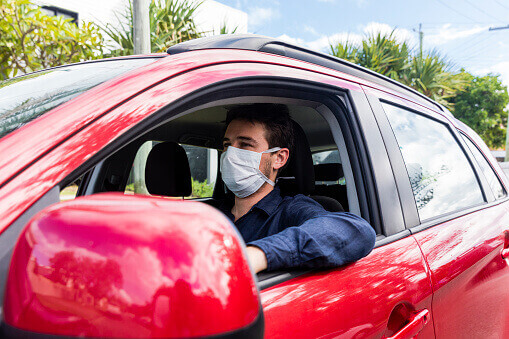For businesses built around driving, COVID-19 poses a lot of risks. According to the Centers for Disease Control and Prevention (CDC), the virus spreads between people who are in close contact (within 6 ft) and through respiratory droplets produced when an infected person coughs, sneezes or talks. This can make being in a car with others especially dangerous.
So, whether your business delivers food to customers or helps drive people to different destinations, you’ll want to make sure your employees are safe while they’re out on the road. The following precautions can help you protect your drivers and your business.
1. Regularly Sanitize Vehicles
Every vehicle has surfaces that multiple people touch. So, if you have more than one employee in a vehicle or multiple customers in your company car each day, you’ll want to develop a list of points of contact. This can include:
- Door handles
- Seat belts
- Windows
- Armrests
- Light and air controls
- Windows
- Grab handles
The CDC recommends using detergent or soap and water first to clean non-porous surfaces inside your car. You can then use household disinfectants or alcohol solutions with at least 70% alcohol in them. You can find products that kill COVID-19 with the CDC’s List N Tool.
It’s also important to share your list of touchpoints with your staff and provide training on how to safely use disinfectants on high-touch areas of the vehicle.
2. Implement New Policies
With so many changes since the virus first emerged, it’s important to update and evolve your business policies. Put guidelines into place to help keep your drivers safe, such as:
- Do not allow multiple employees to be in the same vehicle.
- For situations that require multiple employees working in close proximity, schedule them as teams rather than rotating individuals in and out.
- Provide all employees with masks.
- Route drivers away from high-risk areas.
- Develop guidelines on what to do in the event of an accident. This includes social distancing when sharing information or documentation with another driver.
- Avoid riding with a tow truck driver if the vehicle is in an accident.
- Use virtual driver training for new workers.
- If you provide in-house fleet maintenance:
- Clean all shared tools between each use.
- Only allow service techs in the garage area.
- Have service techs wear single-use gloves.
- If you have codes for documenting the services performed, develop a work code for wiping down vehicles.
You may also want to look at your leave policies for employees. Your policies should be flexible so sick employees can easily stay away from their coworkers.
3. Outline Steps to Take When a Driver or Passenger Tests Positive
It’s important to act quickly when a driver or passenger tests positive for the virus, shows symptoms or comes into contact with someone who’s infected. Below are some steps you can follow if this does occur.
- Immediately quarantine the vehicle.
- Contact an outside company to have the vehicle sanitized.
- If they’re a remote driver, use a tow service to return the vehicle or send the car directly to the contract company for cleaning.
It’s also important to have your employee follow the CDC recommendations if they’ve been exposed. Your employee should monitor their symptoms during this time and contact their medical care provider as needed.
4. Use Preventative Measures
Following preventative measures can help slow the spread of the virus, ultimately helping you save lives in your community. Actions to take for your business can include:
- Giving your employees hand sanitizer and disposable wipes. You can also give them cleaning products to wipe down their vehicles.
- Encouraging any sick drivers to stay home.
- Having your employees stop using the recirculated air option for the car’s ventilation. They can instead use the car’s vents to bring in fresh outside air or lower the windows.
- Having passengers sit in the back seat to allow for increased distance.
- Encouraging your drivers and their passengers to wear masks.
The CDC also recommends that you continue to remind your staff to wash their hands in instances like:
- Using the bathroom
- Before eating
- Blowing their nose
- Coughing
- Sneezing
- Before and after work shifts
- Before and after work breaks
- After handling passengers personal belongings
- After exchanging money with passengers
- Before and after pumping gas
If you run a restaurant, retail food store or other food pick-up/delivery service, you should follow the typical food safety guidelines set by the U.S. Food and Drug Administration while delivering food. On top of these, the CDC recommends:
- Setting up designated pick-up zones for customers to maintain social distancing.
- Practicing social distancing when you deliver food. For instance, you can offer “no touch” deliveries or send text alerts to customers when drivers have arrived.
- Evaluating your facility to identify any changes you need to make to maintain social distancing.
- Regularly cleaning and sanitizing the coolers you use to deliver food.
5. Frequently Communicate With Employees
It’s important to update your workforce regularly on your expectations during COVID-19, but you’ll also want to listen to what their concerns are. You can then assure them and modify your COVID-19 strategy to help accommodate everyone. For instance, you may want to change your leave policy to provide time off for taking care of sick relatives. You’ll also want to update your workforce each time your state releases new information or guidelines.
Remember, your employees are experiencing a lot of uncertainty during this time. To help reassure them and reduce anxiety, it’s important to communicate with empathy and compassion. This can help them stay positive and productive.
Never underestimate the power of cleaning. Sanitizing your company vehicles while following important prevention measures can help protect your employees, customers, business and community. Adding in some new policies on top of this and regularly updating your employees on COVID-19 can help prevent the spread even more. The key is to stay focused, empathetic and compassionate.
Next Steps: Want to learn more? Sign up for the Small Biz Ahead newsletter to receive a weekly roundup of the latest tools, trends, and resources.





